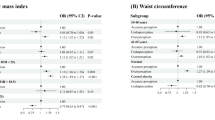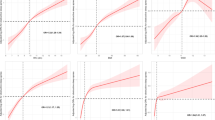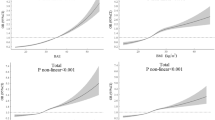Abstract
Study design
Cross-sectional.
Objectives
To determine the obesity cutoff values for body mass index (BMI) and waist circumference (WC) in Korean men with motor complete spinal cord injury (SCI).
Setting
Tertiary level hospital in Seoul, Korea.
Methods
BMI (kg/m2) was calculated and WC (cm) was measured in each participant in the supine position. Percentage of total body fat (%) was determined using whole-body dual-energy X-ray absorptiometry. Receiver operating characteristic curves were generated to determine the obesity cutoff values for BMI and WC. The optimal cutoff values were determined using the Youden index. Identified cutoff values were compared with those of 195 age- and BMI-matched men in the general population (GP), obtained from the Korea National Health and Nutrition Examination Survey.
Results
This study included 52 Korean men with motor complete SCI. A BMI of 20.2 kg/m2 and WC of 81.3 cm were identified as obesity cutoff values in Korean men with motor complete SCI. The area under the curve (AUC) was 0.928, specificity was 100%, and sensitivity was 84.8% according to the ROC curve of BMI for participants. AUC was 0.964, specificity was 100%, and sensitivity was 84.8% in the ROC curve of WC for participants. A BMI of 22.5 kg/m2 and WC of 85.5 cm were identified as obesity cutoff values in age- and BMI-matched men in the GP.
Conclusions
The obesity cutoff values in Korean men with motor complete SCI that were determined in this study were lower than those of the Korean GP and western people with SCI.
Similar content being viewed by others
Log in or create a free account to read this content
Gain free access to this article, as well as selected content from this journal and more on nature.com
or
References
Van Gaal LF, Mertens IL, De Block CE. Mechanisms linking obesity with cardiovascular disease. Nature. 2006;444:875–80.
Silveira SL, Ledoux TA, Robinson-Whelen S, Stough R, Nosek MA. Methods for classifying obesity in spinal cord injury: a review. Spinal Cord. 2017;55:812–7.
Monroe MB, Tataranni PA, Pratley R, Manore MM, Skinner JS, Ravussin E. Lower daily energy expenditure as measured by a respiratory chamber in subjects with spinal cord injury compared with control subjects. Am J Clin Nutr. 1998;68:1223–7.
Buchholz AC, McGillivray CF, Pencharz PB. The use of bioelectric impedance analysis to measure fluid compartments in subjects with chronic paraplegia. Arch Phys Med Rehabil. 2003;84:854–61.
Spungen AM, Adkins RH, Stewart CA, Wang J, Pierson RN Jr., Waters RL, et al. Factors influencing body composition in persons with spinal cord injury: a cross-sectional study. J Appl Physiol. 2003;95:2398–407.
Jones LM, Legge M, Goulding A. Healthy body mass index values often underestimate body fat in men with spinal cord injury. Arch Phys Med Rehabil. 2003;84:1068–71.
Laughton GE, Buchholz AC, Martin Ginis KA, Goy RE, Group SSR. Lowering body mass index cutoffs better identifies obese persons with spinal cord injury. Spinal Cord. 2009;47:757–62.
Deurenberg P, Deurenberg-Yap M, Guricci S. Asians are different from Caucasians and from each other in their body mass index/body fat per cent relationship. Obes Rev. 2002;3:141–6.
Wang J, Thornton JC, Russell M, Burastero S, Heymsfield S, Pierson RN Jr. Asians have lower body mass index (BMI) but higher percent body fat than do whites: comparisons of anthropometric measurements. Am J Clin Nutr. 1994;60:23–8.
Gallagher D, Heymsfield SB, Heo M, Jebb SA, Murgatroyd PR, Sakamoto Y. Healthy percentage body fat ranges: an approach for developing guidelines based on body mass index. Am J Clin Nutr. 2000;72:694–701.
Wang J, Thornton JC, Burastero S, Shen J, Tanenbaum S, Heymsfield SB, et al. Comparisons for body mass index and body fat percent among Puerto Ricans, blacks, whites and Asians living in the New York City area. Obes Res. 1996;4:377–84.
Consultation WHOE. Appropriate body-mass index for Asian populations and its implications for policy and intervention strategies. Lancet. 2004;363:157–63.
Cirnigliaro CM, LaFountaine MF, Dengel DR, Bosch TA, Emmons RR, Kirshblum SC, et al. Visceral adiposity in persons with chronic spinal cord injury determined by dual energy X-ray absorptiometry. Obesity. 2015;23:1811–7.
Nishida C, Ko GT, Kumanyika S. Body fat distribution and noncommunicable diseases in populations: overview of the 2008 WHO Expert Consultation on Waist Circumference and Waist-Hip Ratio. Eur J Clin Nutr. 2010;64:2–5.
Shepherd JA, Fan B, Lu Y, Wu XP, Wacker WK, Ergun DL, et al. A multinational study to develop universal standardization of whole-body bone density and composition using GE Healthcare Lunar and Hologic DXA systems. J Bone Miner Res. 2012;27:2208–16.
Pearson D, Horton B, Green DJ. Cross calibration of Hologic QDR2000 and GE lunar prodigy for whole body bone mineral density and body composition measurements. J Clin Densitom. 2011;14:294–301.
Xu W, Chafi H, Guo B, Heymsfield SB, Murray KB, Zheng J, et al. Quantitative comparison of 2 dual-energy X-ray absorptiometry systems in assessing body composition and bone mineral measurements. J Clin Densitom. 2016;19:298–304.
Malouf J, DiGregorio S, Del Rio L, Torres F, Marin AM, Farrerons J, et al. Fat tissue measurements by dual-energy x-ray absorptiometry: cross-calibration of 3 different fan-beam instruments. J Clin Densitom. 2013;16:212–22.
Perkins NJ, Schisterman EF. The inconsistency of “optimal” cutpoints obtained using two criteria based on the receiver operating characteristic curve. Am J Epidemiol. 2006;163:670–5.
Ravensbergen HR, Lear SA, Claydon VE. Waist circumference is the best index for obesity-related cardiovascular disease risk in individuals with spinal cord injury. J Neurotrauma. 2014;31:292–300.
Inayama T, Higuchi Y, Tsunoda N, Uchiyama H, Sakuma H. Associations between abdominal visceral fat and surrogate measures of obesity in Japanese men with spinal cord injury. Spinal Cord. 2014;52:836–41.
Rajan S, McNeely MJ, Warms C, Goldstein B. Clinical assessment and management of obesity in individuals with spinal cord injury: a review. J Spinal Cord Med. 2008;31:361–72.
Gorgey AS, Dolbow DR, Dolbow JD, Khalil RK, Castillo C, Gater DR. Effects of spinal cord injury on body composition and metabolic profile - part I. J Spinal Cord Med. 2014;37:693–702.
Eriks-Hoogland I, Hilfiker R, Baumberger M, Balk S, Stucki G, Perret C. Clinical assessment of obesity in persons with spinal cord injury: validity of waist circumference, body mass index, and anthropometric index. J Spinal Cord Med. 2011;34:416–22.
Cragg JJ, Ravensbergen HJ, Borisoff JF, Claydon VE. Optimal scaling of weight and waist circumference to height for adiposity and cardiovascular disease risk in individuals with spinal cord injury. Spinal Cord. 2015;53:64–8.
Maki KC, Briones ER, Langbein WE, Inman-Felton A, Nemchausky B, Welch M, et al. Associations between serum lipids and indicators of adiposity in men with spinal cord injury. Paraplegia. 1995;33:102–9.
Buchholz AC, Bugaresti JM. A review of body mass index and waist circumference as markers of obesity and coronary heart disease risk in persons with chronic spinal cord injury. Spinal Cord. 2005;43:513–8.
Gorgey AS, Dolbow DR, Gater DR. A model of prediction and cross-validation of fat-free mass in men with motor complete spinal cord injury. Arch Phys Med Rehabil. 2012;93:1240–5.
Acknowledgements
We thank Hye-Ri Kim, Il-Young Jung, and Ja-Ho Leigh for contributing to the data collection. This study was supported by the Bio & Medical Technology Development Program of the National Research Foundation of Korea.
Author contributions
JHY was responsible for extracting and analyzing data, interpreting results, creating the figures and writing the report. He contributed to designing the study and collecting data. SMC was responsible for designing the study, writing the initial protocol, collecting data. He contributed to interpreting results and writing the report. JCK was responsible for analyzing data, writing the report and updating reference lists. He contributed to collecting data and interpreting the results. HIS was responsible for designing the study, collecting data, interpreting the results. He provided feedback on the report and approved the final version.
Funding
This study was funded by the Ministry of Science, ICT, and Future Planning (2013R1A1A2010246).
Author information
Authors and Affiliations
Corresponding author
Ethics declarations
Statement of ethics
All applicable institutional and governmental regulations concerning the ethical use of human volunteers were followed during the course of this research. The study was approved by the Institutional Review Board of Seoul National Hospital (IRB No. 1412-115-634), and written informed consent was obtained from all study participants.
Conflict of interest
The authors declare that they have no conflict of interest.
Rights and permissions
About this article
Cite this article
Yun, JH., Chun, SM., Kim, JC. et al. Obesity cutoff values in Korean men with motor complete spinal cord injury: body mass index and waist circumference. Spinal Cord 57, 110–116 (2019). https://doi.org/10.1038/s41393-018-0172-1
Received:
Revised:
Accepted:
Published:
Issue date:
DOI: https://doi.org/10.1038/s41393-018-0172-1



